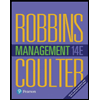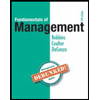Discuss the need for human resource planning in Organization
Chapter1: Taking Risks And Making Profits Within The Dynamic Business Environment
Section: Chapter Questions
Problem 1CE
Related questions
Question
Discuss the need for human resource planning in Organizations
Expert Solution
Step 1: Context Setting
| Aspect | Explanation | Example |
|---|---|---|
| Organizational Growth | Human resource planning is essential to align an organization's workforce with its growth objectives. Without planning, an organization may struggle to meet increased demand for its products or services. | Example: A tech startup anticipates rapid growth in the next year due to increased customer demand. Without HR planning, they may not have enough skilled developers to meet project deadlines, leading to customer dissatisfaction. |
| Talent Acquisition | HR planning helps identify talent gaps and allows organizations to proactively recruit and hire the right people. This ensures that the workforce has the necessary skills and qualifications to fulfill organizational goals. | Example: A retail chain plans to expand into a new region. HR planning identifies the need for local sales and customer service staff to ensure smooth operations in the new area. |
| Skill Development | It aids in identifying skill deficiencies among employees and devising training programs to enhance their capabilities. This fosters employee growth and improves their contribution to the organization. | Example: A manufacturing company identifies a lack of expertise in using new automated machinery. HR planning initiates training programs to upskill existing employees, reducing reliance on external hires. |
| Succession Planning | HR planning includes succession planning, ensuring that the organization has a pool of talented individuals ready to assume key roles when needed, reducing disruptions during leadership transitions. | Example: A CEO plans to retire in two years. HR planning identifies and grooms an internal candidate to seamlessly step into the role when the CEO retires. |
| Cost Control | It helps manage labor costs efficiently by ensuring the right number of employees are in place. Without proper planning, organizations may face overstaffing or understaffing issues, leading to increased costs. | Example: A hotel chain experiences seasonal fluctuations in occupancy. HR planning helps schedule staff accordingly, reducing overtime costs during peak seasons and minimizing layoffs during low seasons. |
| Diversity and Inclusion | HR planning can support diversity and inclusion efforts by identifying areas where the organization lacks diversity and taking steps to attract and retain a more diverse workforce. | Example: A tech company realizes it lacks gender diversity in its engineering department. HR planning includes targeted recruitment strategies and initiatives to foster a more inclusive work environment. |
| Compliance | Ensuring that the organization complies with labor laws, regulations, and industry standards is crucial. HR planning includes compliance measures to avoid legal issues and penalties. | Example: A pharmaceutical company updates its HR policies to align with new regulations regarding employee safety. HR planning ensures that these policies are implemented company-wide to avoid legal consequences. |
| Employee Engagement | HR planning can identify factors affecting employee morale and engagement, allowing organizations to implement strategies to improve workplace satisfaction and reduce turnover. | Example: An IT company notices a high turnover rate among software developers. HR planning conducts exit interviews and identifies issues with work-life balance. Measures like flexible hours and remote work options are implemented to improve retention. |
In summary, human resource planning is a comprehensive process that addresses various aspects of workforce management to ensure an organization's success and sustainability. It involves aligning the workforce with organizational goals, acquiring and developing talent, controlling costs, promoting diversity and inclusion, ensuring compliance, and enhancing employee engagement.
Step by step
Solved in 3 steps

Recommended textbooks for you

Understanding Business
Management
ISBN:
9781259929434
Author:
William Nickels
Publisher:
McGraw-Hill Education

Management (14th Edition)
Management
ISBN:
9780134527604
Author:
Stephen P. Robbins, Mary A. Coulter
Publisher:
PEARSON

Spreadsheet Modeling & Decision Analysis: A Pract…
Management
ISBN:
9781305947412
Author:
Cliff Ragsdale
Publisher:
Cengage Learning

Understanding Business
Management
ISBN:
9781259929434
Author:
William Nickels
Publisher:
McGraw-Hill Education

Management (14th Edition)
Management
ISBN:
9780134527604
Author:
Stephen P. Robbins, Mary A. Coulter
Publisher:
PEARSON

Spreadsheet Modeling & Decision Analysis: A Pract…
Management
ISBN:
9781305947412
Author:
Cliff Ragsdale
Publisher:
Cengage Learning

Management Information Systems: Managing The Digi…
Management
ISBN:
9780135191798
Author:
Kenneth C. Laudon, Jane P. Laudon
Publisher:
PEARSON

Business Essentials (12th Edition) (What's New in…
Management
ISBN:
9780134728391
Author:
Ronald J. Ebert, Ricky W. Griffin
Publisher:
PEARSON

Fundamentals of Management (10th Edition)
Management
ISBN:
9780134237473
Author:
Stephen P. Robbins, Mary A. Coulter, David A. De Cenzo
Publisher:
PEARSON